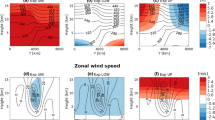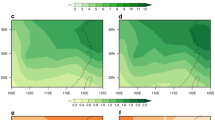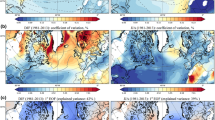Abstract
Observations and results of numerical experiments with climate models under different green-house-gas emission scenarios point to a reconstruction of the thermal and circulation atmospheric regime induced by global climate changes. In particular, an increase in atmospheric static stability, a poleward shift of midlatitude storm tracks, a decrease in the frequency of extratropical cyclones, and a change in their intensity are found at tropical and middle latitudes. This paper, using a simplified idealized model of baroclinic instability, investigates the influence of small variations in the basic atmospheric parameters governing the development of baroclinic instability, namely, static stability and the vertical quasi-zonal flow velocity shear induced by a meridional temperature gradient, on variations in the growth rate of the amplitude of synopticscale unstable waves. Analytical expressions are derived for absolute and relative sensitivity functions to estimate the absolute and relative contribution of variations in the static stability and the vertical flow velocity shear to a change in the growth rate of the amplitude of unstable modes.
Similar content being viewed by others
References
L. T. Matveev, Theory of Atmospheric General Circulation and the Earth’s Climate(Gidrometeoizdat, Leningrad, 1991) [in Russian].
J. R. Holton, An Introduction to Dynamic Meteorology (Academic, New York, 1992).
V. P. Dymnikov and A. N. Filatov, Stability of Large-Scale Atmospheric Processes (Gidrometeoizdat, Leningrad, 1990) [in Russian].
V. P. Dymnikov, Stability and Predictability of Large-Scale Atmospheric Processes (IVM RAN, Moscow, 2007) [in Russian].
R. T. Pierrehumbert and K. L. Swanson, “Baroclinic instability,” Ann. Rev. Fluid Mech. 27, 419–467 (1995).
Special Report on Emissions Scenarios. A Special Report of Working Group III of the Intergovernmental Panel on Climate Change, Ed. by R. Nakicenovic and R. Swart (Cambridge University Press, Cambridge, 2000).
I. I. Mokhov, O. I. Mokhov, V. K. Petukhov, and R. R. Khairullin, “The effect of global climatic changes on atmospheric eddy activity,” Izv., Akad. Nauk, Fiz. Atmos. Okeana 28(1), 11–26 (1992).
S. J. Lambert, “The effect of enhanced greenhouse warming on winter cyclone frequencies and strengths,” J. Clim. 8(5), 1447–1452 (1995).
F. Lunkeit, K. Fraedrich, and S. E. Bauer, “Storm tracks in a warmer climate: Sensitivity studies with a simplified global circulation model,” Clim. Dyn. 14(11), 813–826 (1998).
S. K. Gulev, O. Zolina, and S. Grigoriev, “Extratropical cyclone variability in the Northern Hemisphere winter from the NCEP/NCAR reanalysis data,” Clim. Dyn. 17(10), 795–809 (2001).
I. I. Mokhov, P. F. Demchenko, A. V. Eliseev, et al., “Estimation of global and regional climate changes during the 19th-21st centuries on the basis of the IAP RAS model with consideration for anthropogenic forcing,” Izv., Atmos. Ocean. Phys. 38(5), 555–568 (2002).
Q. Geng and M. Sugi, “Possible change of extratropical cyclone activity due to enhanced greenhouse gases and sulphate aerosols-study with a high-resolution AGCM,” J. Clim. 16(13), 2262–2274 (2003).
J. H. Yin, “A consistent poleward shift of the storm tracks in simulations of 21st century climate,” Geophys. Res. Lett. 32, L18701 (2005).
L. Bengtsson, K. I. Hodges, and E. Roeckner, “Storm tracks and climate change,” J. Clim. 19(15), 3518–3543 (2006).
X. L. Wang, V. R. Swail, and F. W. Zviers, “Climatology and changes of extratropical cyclone activity: Comparison of ERA-40 with NCEP-NCAR reanalysis for 1958–2001,” J. Clim. 19(13), 3145–3166 (2006).
S. J. Lambert and J. C. Fyfe, “Changes in winter cyclones frequencies and strengths simulated in enhanced greenhouse warming experiments: results from the models participating in the IPCC diagnostic exercise,” Clim. Dyn. 26(7–8), 713–728 (2006).
Y. Wu, M. Ting, R. Seager, et al., “Changes in storm tracks and energy transports in a warmer climate simulated by the GFDL CM2.1 model,” Clim. Dyn. 37(1–2), 53–72 (2011).
M. G. Akperov and I. I. Mokhov, “Estimates of the sensitivity of cyclonic activity in the troposphere of extratropical latitudes to changes in the temperature regime,” Izv., Atmos. Ocean. Phys. 49(2), 113–120 (2013).
C. Mbengue and T. Schneider, “Storm track shift under climate change: What can be learned from large-scale dry dynamics,” J. Clim. 26(24), 9923–9930 (2013).
M. N. Juckes, “The static stability of the midlatitude troposphere: The relevance of moisture,” J. Atmos. Sci. 57(18), 3050–3057 (2000).
D. M. W. Frierson, “Robust increases in midlatitude static stability in global warming simulations,” Geophys. Res. Lett. 33, L24816 (2006).
D. M. W. Frierson, “Midlatitude static stability in simple and comprehensive general circulation models,” J. Atmos. Sci. 65(3), 1049–1062 (2008).
K.-M. Xu and K. A. Emanuel, “Is the tropical atmosphere conditionally unstable?,” Mon. Wea. Rev. 117(7), 1471–1479 (1989).
R. J. Allen and S. C. Sherwood, “Warming maximum in the tropical upper troposphere deduced from thermal wind observations,” Nature Geosci. 1(6), 399–403 (2008).
E. T. Eady, “Long waves and cyclone waves,” Tellus 1(3), 33–52 (1949).
V. P. Dymnikov, “Development of baroclinic instability in the atmosphere with a variable parameter of static stability,” Izv. Akad. Nauk, Fiz. Atmos. Okeana 14(5), 493–500 (1978).
S. J. Lindzen and B. F. Farrell, “A simple approximate result for maximum growth rate of baroclinic instabilities,” J. Atmos. Sci. 37(7), 1648–1654 (1980).
J. S. Frederiksen and C. S. Frederiksen, Decadal Changes in Southern Hemisphere Winter Cyclogenesis (CSIRO Marine and Atmospheric Research Paper no. 2) (CSIRO, Aspendale, 2005).
J. S. Frederiksen and C. S. Frederiksen, “Inter-decadal changes in southern hemisphere winter storm track modes,” Tellus 59(5), 599–617 (2007).
I. A. Pisnichenko, “Influence of variable static stability on the dynamics of ultra long waves in a two-dimensional baroclinic atmosphere,” Izv. Akad. Nauk, Fiz. Atmos. Okeana 19(11), 924–927 (1983).
A. M. Obukhov, “On the problem of geostrophic wind,” Izv. Akad. Nauk, Ser. Geograf. Geofiz. 13(4), 281–306 (1949).
A. Brown, S. Milton, M. Cullen, B. Golding, J. Mitchell, and A. Shelly, “Unified modeling and prediction of weather and climate: A 25-year journey,” Bull. Am. Meteorol. Soc. 93(12), 1865–1877 (2012).
Author information
Authors and Affiliations
Corresponding author
Additional information
Original Russian Text © S.A. Soldatenko, 2014, published in Izvestiya AN. Fizika Atmosfery i Okeana, 2014, Vol. 50, No. 6, pp. 630–638.
Rights and permissions
About this article
Cite this article
Soldatenko, S.A. Influence of atmospheric static stability and meridional temperature gradient on the growth in amplitude of synoptic-scale unstable waves. Izv. Atmos. Ocean. Phys. 50, 554–561 (2014). https://doi.org/10.1134/S0001433814060152
Received:
Accepted:
Published:
Issue Date:
DOI: https://doi.org/10.1134/S0001433814060152




